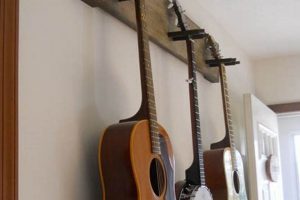A self-assembled climbing structure situated within the confines of a building, constructed by the user rather than purchased pre-made, offers a recreational and exercise-oriented amenity. Such a structure typically involves affixing climbing holds to a prepared wall surface, providing a vertical or overhanging route for climbing activities.
The creation of such an amenity allows for customized fitness regimens, accessible year-round regardless of external weather conditions. Historically, indoor climbing facilities were limited to commercial gyms; however, the rise of readily available materials and online instructional resources has fostered the democratization of this sport, enabling individuals to incorporate it into their domestic environments. The benefits extend beyond physical well-being, fostering problem-solving skills and spatial reasoning.
The subsequent sections will delve into critical aspects pertaining to the design, construction, and safety considerations relevant to creating such a structure. Key areas of focus include structural integrity, appropriate material selection, hold placement strategies, and essential safety protocols to ensure a secure climbing experience.
Essential Construction Considerations
The following guidance addresses critical aspects of design and construction, intended to maximize structural safety and usability.
Tip 1: Wall Reinforcement is Paramount. Prior to initiating construction, assess the existing wall structure. Reinforcement with additional framing members, such as 2x4s or 2x6s spaced at regular intervals (e.g., 12-16 inches on center), is often necessary to distribute the load exerted by a climber.
Tip 2: Plywood Selection Directly Impacts Safety. Utilize high-quality plywood, specifically designed for structural applications. A minimum thickness of 3/4 inch is recommended to provide sufficient strength for securely mounting climbing holds. Avoid using thinner or lower-grade plywood that may be prone to failure under stress.
Tip 3: T-Nut Installation Requires Precision. Ensure accurate and consistent installation of T-nuts to facilitate hold attachment. Utilize a consistent grid pattern for T-nut placement (e.g., every 4-8 inches). This allows for versatile route setting and prevents concentrated stress on individual fasteners.
Tip 4: Hold Placement Strategically Influences Difficulty. Vary hold sizes, shapes, and orientations to create diverse climbing routes. Consider the intended skill level of users and adjust hold spacing accordingly. Experiment with overhangs and angles to increase the challenge.
Tip 5: Safety Matting Mitigates Fall Risk. Implement a comprehensive safety matting system beneath the wall. High-density foam pads, meeting established fall height standards, are essential to minimize the potential for injuries resulting from falls. Ensure the matting extends adequately beyond the wall’s perimeter.
Tip 6: Regular Inspection Maintains Structural Integrity. Implement a routine inspection schedule to identify and address potential issues. Inspect the wall structure, T-nuts, climbing holds, and safety matting for signs of wear, damage, or loosening. Promptly repair or replace any compromised components.
Tip 7: Anchor Points for Top-Roping Enhance Safety (if applicable). If top-roping is intended, install secure and properly rated anchor points at the top of the wall. These anchor points must be capable of withstanding significant forces and should be inspected regularly by a qualified professional.
Adhering to these guidelines promotes a more robust and secure climbing environment. The investment in proper planning and construction materials is crucial for ensuring long-term safety and enjoyment.
The following section will address advanced techniques in climbing routes for different climbing experience.
1. Structural Integrity
The relationship between structural integrity and a self-constructed climbing apparatus is one of direct and undeniable causality. The load-bearing capacity and stability of the wall are paramount, dictating its safety and usability. Insufficient structural robustness invariably leads to potential failure, risking significant physical harm to the user. The construction materials must withstand dynamic forces generated during climbing, including abrupt weight shifts and concentrated pressure on individual holds. For example, inadequate wall framing, using substandard lumber, or improperly installed fasteners can result in deformation or collapse under load. This understanding is not merely theoretical; documented cases of climbing wall failures underscore the practical significance of adhering to rigorous structural standards.
Analysis reveals that several factors contribute to maintaining adequate structural integrity. These include the correct selection of materials, such as using appropriately rated plywood and fasteners, and the implementation of proper construction techniques. For instance, framing members must be adequately sized and spaced to distribute weight evenly across the wall surface. Plywood should be securely fastened to the framing with screws rather than nails, providing greater resistance to pull-out forces. Furthermore, T-nuts, used to attach climbing holds, must be correctly installed and tightened to prevent loosening or stripping during use. Regular inspection of the wall and its components is also essential to identify and address potential weaknesses before they escalate into hazardous conditions. Failure to properly assess the existing wall structure before reinforcement is a common mistake; some walls may require substantial modifications to safely support the loads imposed by climbing.
In summary, structural integrity constitutes the bedrock of a safe and functional, self-assembled climbing wall. The consequences of neglecting this fundamental aspect are severe, ranging from minor injuries to catastrophic structural failure. Proper material selection, meticulous construction practices, and ongoing maintenance are crucial for mitigating these risks. By prioritizing structural integrity, the self-builder can ensure that the climbing wall provides a challenging and enjoyable activity without compromising safety.
2. Hold Placement
Hold placement directly influences the usability, challenge, and safety of a self-constructed climbing structure. It dictates the routes possible on the wall, their difficulty, and the physical demands placed on the climber. In essence, hold placement is the means by which a static wall transforms into a dynamic and engaging climbing experience. A poorly planned configuration can lead to routes that are either too easy and uninteresting or too difficult and potentially dangerous. The selection of holds, their orientation, and their spatial relationship to each other collectively determine the wall’s character.
Consider, for example, a scenario where holds are placed too far apart, creating excessive reach requirements. This configuration may exclude climbers with shorter wingspans or those with less developed strength. Conversely, holds positioned too close together can result in “ladder-like” routes that lack technical challenge. The effective placement of holds requires a consideration of ergonomics, biomechanics, and the intended skill level of the users. Varying hold typesjugs, crimps, slopers, pinchesadds complexity and replicates real-rock climbing situations, enhancing the training value. Furthermore, the intentional creation of sequences that require specific movements, such as dynos (dynamic leaps) or heel hooks, introduces additional dimensions to the climbing experience. Real-world examples include the replication of specific rock climbing routes on indoor walls, a practice commonly employed in commercial climbing gyms to train for outdoor ascents.
Effective hold placement is a blend of art and science. It demands an understanding of climbing technique, human physiology, and spatial reasoning. The ability to visualize the flow of a climb and anticipate the movements required is crucial. While experimentation and adjustment are inherent to the process, a deliberate and informed approach to hold placement is essential for creating a challenging, safe, and enjoyable climbing structure. The strategic use of hold spacing, angle, and type makes the difference between a wall that is climbed once and one that is climbed many times. Neglecting this aspect diminishes the investment in time, materials, and space.
3. Material Selection
Material selection directly influences the structural integrity, longevity, and safety of a self-constructed climbing structure. The materials employed constitute the physical foundation upon which the climbing experience is built, bearing the load of climbers and withstanding repetitive stress. Inadequate material choices can compromise the entire system, leading to premature failure and potential injuries. For example, the use of low-grade plywood, lacking sufficient thickness or lamination strength, can result in delamination or fracture under load. Similarly, substandard fasteners, such as insufficiently rated screws or bolts, can fail to adequately secure the climbing holds, creating a hazardous situation.
The practical implications of informed material selection are considerable. Selecting appropriate framing lumber, such as kiln-dried 2x4s or 2x6s, ensures adequate support and stability. Using 3/4-inch or thicker plywood with a high shear strength provides a robust surface for mounting climbing holds. Implementing T-nuts manufactured from hardened steel, combined with appropriately sized bolts, establishes a secure and reliable attachment mechanism. Moreover, considering the environmental conditions, such as humidity or temperature fluctuations, can guide the selection of materials that resist warping, corrosion, or degradation over time. For example, the use of pressure-treated lumber in damp environments can prevent rot and extend the lifespan of the climbing structure. Professional climbing gyms frequently use specialized climbing wall panels constructed from composite materials, which offer superior strength, durability, and resistance to wear and tear. While potentially more expensive, these materials provide a significant advantage in terms of performance and safety.
In summary, the careful and considered selection of materials is not a mere formality but a critical element in the creation of a safe and durable climbing apparatus. The relationship between material quality and structural integrity is inextricably linked, underscoring the need for diligent research and informed decision-making. While budgetary constraints may influence material choices, prioritizing safety and longevity should remain paramount. The long-term cost of substandard materials often outweighs the initial savings, considering the potential for repairs, replacements, and, most importantly, injuries. Therefore, thorough evaluation of material properties and adherence to established construction standards are essential for ensuring a reliable and enjoyable climbing experience.
4. Safety Matting
The inclusion of safety matting in the construction of a self-assembled indoor climbing structure is not an optional addition but a fundamental safety requirement. The causal relationship is direct: falls are an inherent part of climbing, and safety matting serves to mitigate the impact forces generated during these falls, reducing the likelihood of injury. The absence of adequate safety matting transforms a recreational activity into a potentially hazardous pursuit. Consider the scenario of a climber losing grip at a height of several feet; without appropriate impact absorption, the force of the fall can result in sprains, fractures, or more severe trauma. Real-world examples of climbing injuries underscore the critical importance of adequate fall protection. Emergency room statistics consistently demonstrate a correlation between climbing-related injuries and inadequate safety measures, including the absence of or insufficient safety matting. Therefore, the practical significance of this understanding is undeniable: safety matting is an essential component, not a peripheral accessory, of the climbing structure.
Analysis reveals that the effectiveness of safety matting depends on several factors. The thickness and density of the matting materials are crucial determinants of impact absorption capacity. High-density foam pads, typically ranging from 8 to 12 inches in thickness, are commonly used to provide adequate protection for falls from moderate heights. The surface area covered by the matting is also significant; the matting should extend sufficiently beyond the base of the climbing wall to accommodate potential fall trajectories. Furthermore, the condition of the matting must be regularly inspected and maintained. Compression or damage to the foam can diminish its impact absorption properties, requiring replacement or repair. Professional climbing gyms often utilize multi-layered matting systems, combining different densities of foam to optimize impact absorption across a range of fall heights and weights. These systems represent a best-practice approach to safety matting that can be adapted, albeit at a cost, for self-constructed climbing walls.
In summary, safety matting is an indispensable element of any self-assembled indoor climbing structure, serving as the primary line of defense against fall-related injuries. The effectiveness of the matting hinges on its thickness, density, coverage area, and maintenance. Challenges associated with implementing effective safety matting include cost considerations and the need for regular inspections and replacements. However, the investment in proper safety matting is a non-negotiable aspect of responsible construction, directly contributing to the safety and enjoyment of the climbing activity. It is integral to ensuring the longevity and safety of a well-designed, do-it-yourself climbing wall.
5. Route Diversity
Route diversity represents a critical factor in maximizing the long-term utility and engagement provided by a self-constructed indoor climbing structure. The range of climbing routes available directly influences the physical and mental challenges presented, impacting user satisfaction and skill development.
- Variance in Hold Types
The selection and distribution of diverse hold types are essential for creating varied climbing experiences. Implementing jugs, crimps, slopers, pinches, and pockets necessitates different grip strengths and climbing techniques. Jugs facilitate beginner-friendly routes, while crimps and slopers demand more advanced finger and body positioning skills. This diversification allows for progressive skill development and caters to multiple ability levels within a single structure.
- Adjustable Difficulty Levels
Route diversity extends beyond hold types to encompass variations in route difficulty. This is achieved through adjustments in hold spacing, angle, and overall route length. Denser hold configurations with closer spacing typically represent easier routes, while longer reaches and more challenging sequences contribute to higher difficulty grades. The intentional design of routes catering to beginner, intermediate, and advanced climbers maximizes the structure’s versatility and accessibility.
- Re-routability and Adaptability
The ability to easily reconfigure and adapt routes is a significant advantage offered by a self-constructed climbing apparatus. By employing a standardized T-nut grid system, hold positions can be readily altered to create new routes or modify existing ones. This adaptability prevents stagnation and allows for the continual evolution of the climbing experience. Commercial climbing gyms frequently reset routes to maintain member engagement; this principle is equally applicable to a structure within a private residence.
- Incorporation of Climbing Features
Beyond hold placement, route diversity can be further enhanced through the incorporation of climbing-specific features. Overhangs, artes, and dihedrals introduce additional dimensions and technical challenges to the climbing experience. Overhangs demand significant upper body strength, while artes require precise footwork and balance. These features simulate real-rock climbing scenarios and contribute to a more engaging and comprehensive training environment.
The integration of these facets of route diversity is central to ensuring the sustained appeal and functionality of an indoor climbing wall. By optimizing the range of challenges and experiences provided, the structure transforms from a static fixture into a dynamic and adaptable training resource.
Frequently Asked Questions
The following addresses common inquiries regarding the design, construction, and safety of self-assembled climbing structures.
Question 1: Is professional construction expertise required for building a safe and reliable self-assembled climbing wall?
While formal certification is not mandated, a thorough understanding of structural engineering principles and construction techniques is strongly recommended. Individuals lacking such expertise should consult with qualified professionals to ensure adherence to safety standards.
Question 2: What is the minimum space requirement for constructing a functional self-assembled climbing wall?
The required space depends on the intended wall dimensions and climbing style. A minimum ceiling height of eight feet and a wall area of at least eight feet wide by ten feet high is generally recommended for basic climbing routes. More advanced configurations may necessitate greater spatial allowances.
Question 3: What is the recommended maintenance schedule for a self-assembled climbing wall?
Regular inspections should be conducted at least monthly to identify any loose holds, damaged T-nuts, or structural weaknesses. Holds should be cleaned periodically to maintain grip, and safety matting should be inspected for wear and tear.
Question 4: What types of climbing holds are most suitable for a self-assembled climbing wall?
A variety of hold types, including jugs, crimps, slopers, and pinches, should be incorporated to create diverse and challenging routes. The selection of hold materials should prioritize durability and resistance to wear.
Question 5: How can the risk of injury be minimized when using a self-assembled climbing wall?
Adequate safety matting is paramount. Climbers should always perform a pre-climb inspection of the wall and holds, and warm-up exercises are essential. Novice climbers should seek guidance from experienced individuals or climbing instructors.
Question 6: Are there specific building codes or regulations that govern the construction of self-assembled climbing walls?
Local building codes may apply, particularly if the wall is integrated into a load-bearing structure. It is the responsibility of the builder to ascertain and comply with all applicable regulations.
Adhering to sound construction practices, implementing comprehensive safety measures, and conducting routine maintenance are crucial for ensuring the longevity and safety of a self-assembled climbing structure. Prudent planning and diligent execution are paramount.
The subsequent section will discuss the financial aspects of construction.
Conclusion
The preceding analysis underscores the multifaceted nature of the “diy indoor climbing wall” endeavor. From initial structural considerations to the nuances of hold placement and the criticality of safety measures, numerous elements demand meticulous attention. The creation of such a facility necessitates a comprehensive understanding of construction principles, material properties, and risk mitigation strategies. Successful implementation hinges on diligent planning and unwavering adherence to established safety protocols.
The information presented serves as a foundational guide for those contemplating the construction of a climbing apparatus. The responsible application of this knowledge is paramount. The commitment to safety, structural integrity, and ongoing maintenance is not merely advisable but absolutely essential. Prospective builders are encouraged to seek professional consultation and prioritize safety above all other considerations. The ultimate success of a “diy indoor climbing wall” project lies not only in its construction but in the enduring safety and enjoyment it provides to its users.







